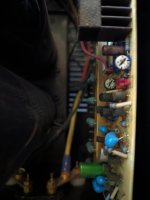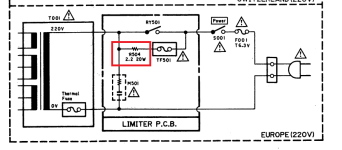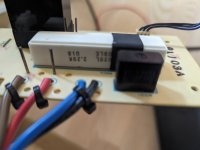Looking to buy this nakamichi pa7. But the current owner tried to set the bias, and seemingly adjusted resistor VR12L instead of VR11L. It has now blown the fuse and wont start.
I am allowed to bring my multimeter and check it when I pick it up.
Any ideas how I should set the VR12L to avoid blowing the fuse again? Dont think its mentioned in the service manual
Thanks
I am allowed to bring my multimeter and check it when I pick it up.
Any ideas how I should set the VR12L to avoid blowing the fuse again? Dont think its mentioned in the service manual
Thanks
Attachments
Last edited:
Thanks. Couldnt get the other one to work :s
Your multiple accounts have been merged.
Seller is a good friend of mine, so I have no reason to doubt his story. Apparently he tried to adjust bias, the unit started getting hotter for a few seconds, then immediately shut off. Upon googling the unit, I have realized that theres a thermal fuse inside the transformer that could possibly burn. However, it seems like that is only likely to happen after running way too hot for a very long time, which isnt the case here.
The main fuse is blown (visible black and no connection through it). On the limiter PCB, both the fuse and the thermo fuse are fine.
Upon replacing the main fuse, it still won't power on. No sign of life at all - no diodes turning on, no clicking relays.. nothing.
Since there doesnt seem to be any current flowing to the amplifer boards, I suppose that the culprit should be found in either the transformer or the limiter PCB. Right?
I will get it home to check it. When I do, are there any obvious things to check as the first steps?
I read about an inrush current limiting resistor, which I suppose would be in the limiter PCB?
Thanks
The main fuse is blown (visible black and no connection through it). On the limiter PCB, both the fuse and the thermo fuse are fine.
Upon replacing the main fuse, it still won't power on. No sign of life at all - no diodes turning on, no clicking relays.. nothing.
Since there doesnt seem to be any current flowing to the amplifer boards, I suppose that the culprit should be found in either the transformer or the limiter PCB. Right?
I will get it home to check it. When I do, are there any obvious things to check as the first steps?
I read about an inrush current limiting resistor, which I suppose would be in the limiter PCB?
Thanks
That schematic and photo are from a PA-7II, not a PA-7. The PA-7 has 4 resistors and 4 thermal fuses on the Limiter PCB.
As for the cause of the amp playing dead, until RY501 closes (i.e., in the soft-start phase), there will be no power to the main transformer if R504 is open, so yes, it could be the issue (as rayma just posted). But also realize that R504 is a 20W resistor, so there might have been a lot of current flowing and other damage done.
Edit: And it is odd that R504 would have opened during a bias adjust (i.e., after startup was completed), as it should have been out of circuit by then. Perhaps check RY501 carefully, because if it opened after the unit was on, it would force current through R504 and the thermal fuse.
As for the cause of the amp playing dead, until RY501 closes (i.e., in the soft-start phase), there will be no power to the main transformer if R504 is open, so yes, it could be the issue (as rayma just posted). But also realize that R504 is a 20W resistor, so there might have been a lot of current flowing and other damage done.
Edit: And it is odd that R504 would have opened during a bias adjust (i.e., after startup was completed), as it should have been out of circuit by then. Perhaps check RY501 carefully, because if it opened after the unit was on, it would force current through R504 and the thermal fuse.
Last edited:
Just a further note of advice for the OP: What I noticed when I worked on my brother's PA-7, it was a little tricky around the big resistor(s) and thermal fuse(s) on the Limiter PCB. If the PA-7II is like the PA-7, the thermal fuse is tucked under the black heatshrink sleeve on the big resistor, making it fairly easy to mistake leads. I mention this because since this not your unit and you probably aren't very familiar with it, I think it would be easy to mistake the leads unless you cut away the heatshrink, etc.. I also think it would be more probable that the thermal fuse on the Limiter PCB let go before that big resistor, if it was what got hot. So I think it is worth a careful check of both the resistor and the thermal fuse.
My brother had inadvertently power cycled his PA-7 too quickly when he was trying to fix a power switch issue, and the build up of heat in the resistors took out all 4 thermal fuses on the Limiter PCB. This design of soft start does not like to be quickly power cycled! But that was the only damage, so those thermal fuses did their job.
My brother had inadvertently power cycled his PA-7 too quickly when he was trying to fix a power switch issue, and the build up of heat in the resistors took out all 4 thermal fuses on the Limiter PCB. This design of soft start does not like to be quickly power cycled! But that was the only damage, so those thermal fuses did their job.
- Home
- Amplifiers
- Pass Labs
- Nakamichi PA7 resistor



